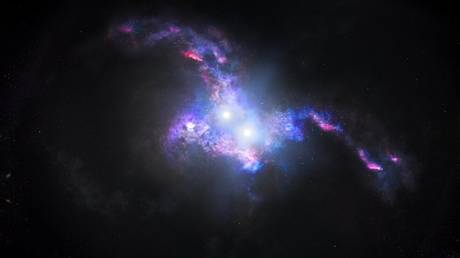

Researchers wielding the almost all-seeing eye on board NASA’s Hubble Space Telescope have detected not one, but two astronomical needles in two galactic haystacks; merging pairs of quasars that may reveal how galaxies form.
By leveraging the wealth of information collected by the European Space Agency’s Gaia satellite and the ground-based Sloan Digital Sky Survey, the researchers narrowed down their hunt for these rare, though extremely bright dual quasars, hiding in plain sight among the stars across the universe.
A quasar is the extremely bright nucleus of a galaxy, fed by the insatiable appetite of a nearby supermassive blackhole, whose voracious eating habits unleash a massive blast of radiation so bright it can outshine entire galaxies like our own Milky Way.
Also on rt.com NASA and ESA release spectacular updated Hubble image of Veil Nebula (PHOTO)
“We estimate that in the distant universe, for every 1,000 quasars, there is one double quasar. So finding these double quasars is like finding a needle in a haystack,” said lead researcher Yue Shen of the University of Illinois at Urbana-Champaign.
By looking back 10 billion years in time, across space, the researchers found a pair of quasars so close to each other they appear to be one particularly violent object. They then, rather serendipitously, found another quasar pair in a separate colliding pair of galaxies.
The discovery will deepen humanity’s understanding of the exact process behind the rather violent coming together of two massive celestial structures, yielding new insights into the merging of galaxies and the collisions of supermassive black holes.
Also on rt.com A distant star just exploded, went nova and is visible from Earth right now
When the quasars, or galactic nuclei, come together, they generate galactic winds which sweep the remaining gas from the merging galaxies, slowing down or outright stopping new star formation, allowing the new, singular galaxy to form into an elliptical shape.
Just over 100 of these double quasars have been discovered thus far, though none as old as these two new pairs. The quasars in each of the two new pairs are only 10,000 light years apart. For reference, the Sun is 26,000 light years from the supermassive black hole at the center of the Milky Way.
Think your friends would be interested? Share this story!
 RSS Feed
RSS Feed















 April 8th, 2021
April 8th, 2021  Awake Goy
Awake Goy  Posted in
Posted in  Tags:
Tags: 













